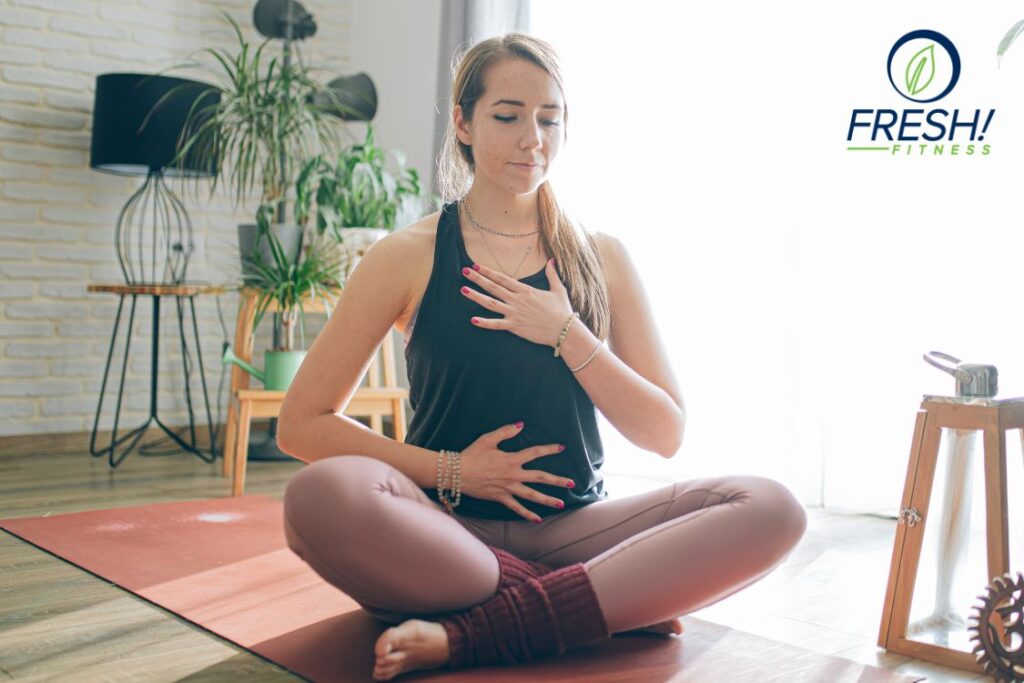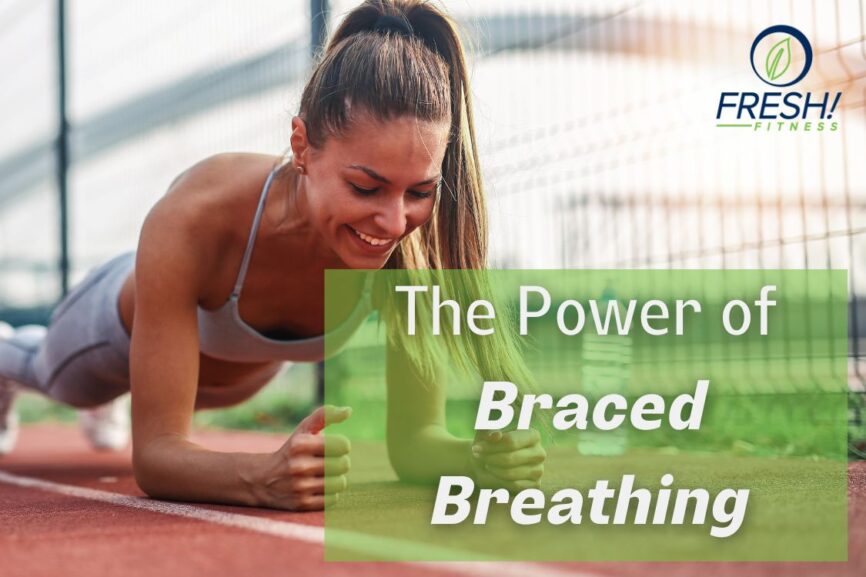In the previous post, we chatted about the importance of belly breathing and braced breathing. Did you get the chance to practice your deep belly breathing over the weekend?
Today we are going to take your breathing to the next level and show you how to get many of the benefits of belly breathing while still protecting your core, improving function, and increasing mobility.
That may seem like a tall order, but it can be done through “Braced Breathing”
That simply means being able to effectively control your core function and withstand internal and external forces on your body while continuing to breathe deeply
The foundation of braced breathing is the bracing process itself. Any joint in the body can be braced (maintain control of your desired position regardless of forces acting on or within the body), but with braced breathing, we will focus primarily on the core (including spinal posture, and pelvic position.
How to Practice Braced Breathing
Begin by making your spine as tall as possible while compressing the abdomen. This is different than “Sucking in your belly”.
When you maintain a tall posture and tighten the core muscles, the abdominal wall becomes compressed, and it provides an incredible foundation of support for movement and function in any area of life.
Most people can do this at the basic level. The challenges come when having to hold that position for more than a few seconds. Typically, as soon as people need to breathe, their spinal and pelvic positions change for the worse.
This change is compounded through exercise, particularly when weights are used. Keep in mind that “weights” can be something as simple as carrying your laptop case or grocery bags.

Propane Tank Analogy
In order to maintain our postural alignment and core activation during breathing, we need a new strategy. A common analogy I use for this concept is a propane tank.
Yes, just like the one you have on your BBQ. Regardless of how full the tank is, it’s always the same size. The only difference is that the pressure inside the tank is much greater when it’s full.
When we brace our core, we set the size of our “tank”
Remember, that size doesn’t change when we breathe. Your breathe and the resulting pressure will progress in 3 general phases.
Phases of Braced Breathing
At the beginning (Phase 1), the pressure will increase inside your abdomen. This helps create support for the spine and our desired body position.
As you keep inhaling (Phase 2), the pressure in the abdomen must go somewhere. You will start to feel increased pressure on the sides of your core, and even towards the low back. Some coaches even use the cue “Breathe into your kidneys”.
As we get to about the halfway mark of our breath volume, the pressure will rise up into the ribcage. This is an important phase.
The ribs are their connected muscle/facia is extremely flexible and able to expand like “bellows”. Few people have practiced tapping into this aspect of breathing and it’s where the biggest improvements can be made.
We can really increase our lung volume and performance in most activities by learning to brace and breathe to “expand our ribcage in 3 dimensions”
Phase 3 is the last phase and encompasses the maximal range of our lung volume.
Under strenuous conditions and maximal lung expansion, it’s common to see more of a “stress breathing response” where the shoulders become elevated and the neck muscles contract. Some of this is normal based on extremely challenging and high-intensity circumstances, but performance begins to be limited at this stage.
As you get better at Phase 2, you will be able to take deeper and deeper breaths and produce more force without entering Phase 3.
Our goal should be to expand phase 2 as long as possible to maximize the lung volume and (relative) relaxation compared to phase 3. This comes with practice and training.
Here are a few great ways to practice your braced breathing
Supine Braced Breathing
- Lie on your back with your feet flat on the floor and knees bent to 90 degrees
- Brace your core (compress abdomen while maintaining posture) and maintain that contraction throughout the entire breath cycle.
- Continue holding contraction and repeat for 3-10 breath cycles.
- Aim to expand your ribcage/lat muscles laterally and into the floor (instead of simply letting your sternum rise and fall)
Standing Braced Breathing
- Stand with ideal posture (not sure, check the image in this article)
- Brace your core (compress abdomen while maintaining posture) and maintain that contraction throughout the entire breath cycle.
- Continue holding contraction and repeat for 3-10 breath cycles.
- Aim to expand your ribcage/lat muscles laterally and behind you (instead of simply letting your sternum rise and fall)
Prone Plank Braced Breathing
- Perform a full plank (from toes) – to make it easier, bring your hands higher off the ground (put them on a box, chair, bench, etc.)
- Brace your core (compress abdomen while maintaining posture) and maintain that contraction throughout the entire breath cycle.
- Continue holding contraction and repeat for 3-10 breath cycles.
- Aim to expand your ribcage/lat muscles laterally and behind you (instead of simply letting your sternum rise and fall)
Once you’ve mastered these drills, start challenging yourself to keep this braced, rib-expanding breathing pattern in more dynamic situations (walking, jogging, running, exercise classes, strength training, etc.)
It will feel awkward at first, but I guarantee you will significantly improve your core control, boost your performance, and reduce your risk of injury.
Not sure what this initial bracing of the core feels like?
Just try coughing hard or laughing heartily while maintaining a tall spinal posture. It also helps to do a Kegel contraction (bracing the pelvic floor…AKA, the bottom of the tank).
Let me know how your practice goes!
Breathe Deeply and…Ignite Your Potential



Comments
I’m definitely going to start doing this. I’m bookmarking this page for future reference, in fact. I definitely don’t brace myself at all.
Glad that we can help 🙂
This is the best explanation of braced breathing I’ve come across. Thank you for describing the process and the benefits.
Thank you for commenting!
Your article on braced breathing and core bracing techniques on Fresh Fitness is incredibly informative! I found the explanations and step-by-step instructions very helpful in understanding the importance of proper breathing and core engagement during workouts. It’s great to learn about techniques that can enhance performance and prevent injuries. Thanks for sharing these valuable insights!
Thanks for the feedback!
Good explanation very informative
Thanks for engaging!
Something new to me. Pinned to digest in more detail later!
Thanks for engaging!
I love this – love how you explained it! Love the videos!
Thanks for commenting!
This is a really cool thing! I’ve never heard about braced breathing before, but I’ve been taking my wellness journey up a notch lately and will definitely have to give this a shot. Thank you for sharing!
And thank you Emily for the feedback!
I have not heard of braced breathing before. This sounds very beneficial and should be included in any fitness journey. It will definitely require some practice but the videos you’ve included are super helpful in getting started!
Maureen
Thanks for the feedback. We are glad that we can help 🙂
Excellent guide to braced breathing! Great visuals!
Thanks for commenting!
Never known of braced breathing. I always try to work on my core, but this seems different. Will surely try it.
Let us know how it went!
This is a very informative and helpful post. I appreciate the tips on how to expand phase 2 and maximise lung volume, which are invaluable, and the suggested ways to practice braced breathing will definitely come in handy. Thank you for sharing this knowledge!
Thank you for the feedback Sonia!
Thanks for introducing this and I have learned a lot from the benefit of practicing braced breathing! Thanks for this useful and informative article!
And thank you for the feedback!
This is such a great informative post about the benefits of braced breathing. I’m going to pin this to my health and fitness board. Thanks
Thank you for engaging!
This is actually very handy as I was literally just talking to someone about breathing and how to core etc so I will be saving this and try to give these exercises a try xx
Give them a try and let us know how it went!
Very useful post. Good tips on helping lung volume and breathing right. I think learning braced breathing would be useful to me.
Definitely would be Richard. Thanks for the feedback!
I had never heard of this, but I think it could be useful for me as I am the lead singer of a cover band.
Great to hear that! Thanks for commenting!
I have tried some breathing techniques while I’m running. It makes such a big difference. I never heard of the term “braced breathing” before, and this is so interesting. I will have to try this technique.
Try them out and let us know how it went!
I wanted to start breathing techniques, but they looked very confusing. I`ll try following your tips and see what happens. Thank you for this guide.
Thank you for the feedback, and good luck!
Your guide to braced breathing is incredibly thorough and informative! I appreciated how you broke down the process step by step, making it easy to understand and implement. The propane tank analogy was especially effective in visualizing how bracing our core sets the foundation for stability and support, akin to maintaining a consistent size regardless of internal pressure changes.
Your explanation of the phases of braced breathing was insightful, particularly emphasizing the importance of expanding the ribcage in three dimensions to maximize lung volume and performance. The suggested exercises, from supine braced breathing to prone plank braced breathing, offer a practical way to put these concepts into practice and gradually improve core control in various positions.
I found the comparison to coughing or laughing while maintaining tall spinal posture to be a helpful cue for understanding the sensation of initial core bracing. It adds a relatable element to the practice, making it easier to connect with the concept.
Overall, your guide is not only educational but also motivational, encouraging readers to challenge themselves and incorporate braced breathing into dynamic situations to enhance performance and reduce the risk of injury. Thanks for sharing such valuable insights!
We are so glad you found our content helpful and educational. Thank you for a great feedback!
What a wonderful post that I have seen. This is very knowledgeable that individuals must know.
Thanks for commenting!